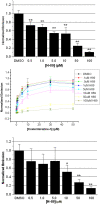The cAMP-dependent protein kinase inhibitor H-89 attenuates the bioluminescence signal produced by Renilla Luciferase
- PMID: 19461967
- PMCID: PMC2680982
- DOI: 10.1371/journal.pone.0005642
The cAMP-dependent protein kinase inhibitor H-89 attenuates the bioluminescence signal produced by Renilla Luciferase
Abstract
Background: Investigations into the regulation and functional roles of kinases such as cAMP-dependent protein kinase (PKA) increasingly rely on cellular assays. Currently, there are a number of bioluminescence-based assays, for example reporter gene assays, that allow the study of the regulation, activity, and functional effects of PKA in the cellular context. Additionally there are continuing efforts to engineer improved biosensors that are capable of detecting real-time PKA signaling dynamics in cells. These cell-based assays are often utilized to test the involvement of PKA-dependent processes by using H-89, a reversible competitive inhibitor of PKA.
Principal findings: We present here data to show that H-89, in addition to being a competitive PKA inhibitor, attenuates the bioluminescence signal produced by Renilla luciferase (RLuc) variants in a population of cells and also in single cells. Using 10 microM of luciferase substrate and 10 microM H-89, we observed that the signal from RLuc and RLuc8, an eight-point mutation variant of RLuc, in cells was reduced to 50% (+/-15%) and 54% (+/-14%) of controls exposed to the vehicle alone, respectively. In vitro, we showed that H-89 decreased the RLuc8 bioluminescence signal but did not compete with coelenterazine-h for the RLuc8 active site, and also did not affect the activity of Firefly luciferase. By contrast, another competitive inhibitor of PKA, KT5720, did not affect the activity of RLuc8.
Significance: The identification and characterization of the adverse effect of H-89 on RLuc signal will help deconvolute data previously generated from RLuc-based assays looking at the functional effects of PKA signaling. In addition, for the current application and future development of bioluminscence assays, KT5720 is identified as a more suitable PKA inhibitor to be used in conjunction with RLuc-based assays. These principal findings also provide an important lesson to fully consider all of the potential effects of experimental conditions on a cell-based assay readout before drawing conclusions from the data.
Conflict of interest statement
Figures




Similar articles
-
Quantification of dynamic protein complexes using Renilla luciferase fragment complementation applied to protein kinase A activities in vivo.Proc Natl Acad Sci U S A. 2007 Oct 23;104(43):16916-21. doi: 10.1073/pnas.0704257104. Epub 2007 Oct 17. Proc Natl Acad Sci U S A. 2007. PMID: 17942691 Free PMC article.
-
Cav1.2 channel current block by the PKA inhibitor H-89 in rat tail artery myocytes via a PKA-independent mechanism: Electrophysiological, functional, and molecular docking studies.Biochem Pharmacol. 2017 Sep 15;140:53-63. doi: 10.1016/j.bcp.2017.05.020. Epub 2017 Jun 2. Biochem Pharmacol. 2017. PMID: 28583845
-
H89 (N-[2-p-bromocinnamylamino-ethyl]-5-isoquinolinesulphonamide) induces autophagy independently of protein kinase A inhibition.Eur J Pharmacol. 2013 Aug 15;714(1-3):170-7. doi: 10.1016/j.ejphar.2013.06.018. Epub 2013 Jun 25. Eur J Pharmacol. 2013. PMID: 23810683
-
The many faces of H89: a review.Cardiovasc Drug Rev. 2006 Fall-Winter;24(3-4):261-74. doi: 10.1111/j.1527-3466.2006.00261.x. Cardiovasc Drug Rev. 2006. PMID: 17214602 Review.
-
T84.66 Anti-CEA diabody-GSTSGSGKPGSGEGSTSG-Renilla luciferase.2008 Sep 18 [updated 2008 Oct 23]. In: Molecular Imaging and Contrast Agent Database (MICAD) [Internet]. Bethesda (MD): National Center for Biotechnology Information (US); 2004–2013. 2008 Sep 18 [updated 2008 Oct 23]. In: Molecular Imaging and Contrast Agent Database (MICAD) [Internet]. Bethesda (MD): National Center for Biotechnology Information (US); 2004–2013. PMID: 20641620 Free Books & Documents. Review.
Cited by
-
Constitutive PKA activity is essential for maintaining the excitability and contractility in guinea pig urinary bladder smooth muscle: role of the BK channel.Am J Physiol Cell Physiol. 2014 Dec 15;307(12):C1142-50. doi: 10.1152/ajpcell.00167.2014. Epub 2014 Oct 15. Am J Physiol Cell Physiol. 2014. PMID: 25318105 Free PMC article.
-
PAINS in the assay: chemical mechanisms of assay interference and promiscuous enzymatic inhibition observed during a sulfhydryl-scavenging HTS.J Med Chem. 2015 Mar 12;58(5):2091-113. doi: 10.1021/jm5019093. Epub 2015 Feb 21. J Med Chem. 2015. PMID: 25634295 Free PMC article.
-
Illuminating insights into firefly luciferase and other bioluminescent reporters used in chemical biology.Chem Biol. 2010 Jun 25;17(6):646-57. doi: 10.1016/j.chembiol.2010.05.012. Chem Biol. 2010. PMID: 20609414 Free PMC article. Review.
-
TRIzol and Alu qPCR-based quantification of metastatic seeding within the skeleton.Sci Rep. 2015 Aug 14;5:12635. doi: 10.1038/srep12635. Sci Rep. 2015. PMID: 26271202 Free PMC article.
-
Profile of the GSK published protein kinase inhibitor set across ATP-dependent and-independent luciferases: implications for reporter-gene assays.PLoS One. 2013;8(3):e57888. doi: 10.1371/journal.pone.0057888. Epub 2013 Mar 7. PLoS One. 2013. PMID: 23505445 Free PMC article.
References
-
- Cohen P. Protein kinases-the major drug targets of the twenty-first century? Nat Rev Drug Disc. 2002;1:309–315. - PubMed
-
- Zhang J, Allen MD. FRET-based biosensors for protein kinases: illuminating the kinome. Mol BioSyst. 2007;3:759–765. - PubMed
-
- Fan F, Wood KV. Bioluminescence Assays for High-Throughput Screening. ASSAY and Drug Dev Technol. 2007;5:127–136. - PubMed
-
- Inglese J, Johnson RL, Simeonov A, Xia M, Zheng W, et al. High-throughput screening assays for the identification of chemical probes. Nat Chem Biol. 2007;3:466–478. - PubMed
Publication types
MeSH terms
Substances
Grants and funding
LinkOut - more resources
Full Text Sources

